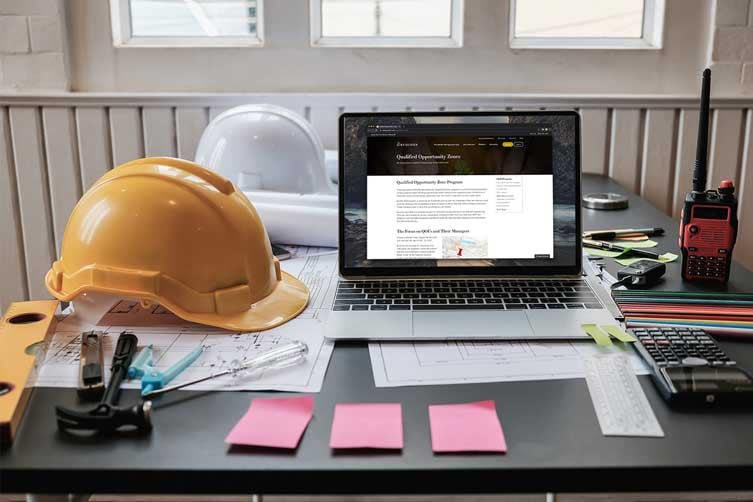
While a great deal of excitement has been generated with the Investment in Opportunity Act, its tax breaks and focus on disadvantaged communities, it’s important to remember one thing. It is, first and foremost, an investment program. Yes, it offers tax deferrals on capital gains. And yes, the vehicle will likely be useful for economic improvements within Qualified Opportunity Zones (QOZs). But before handing your capital gains to a Qualified Opportunity Fund (QOF), plenty of due diligence is required.
In previous articles, we stressed the importance of knowing your targeted QOF’s geographic and property experiences. Also of huge importance is knowing the QOF’s deal types, and where the money is coming from, to bring those projects to fruition.
Decoding “Substantial Improvement”
The Investment in Opportunity Act is an economic improvement initiative, meaning the QOF has two jobs. It needs to find, and buy, a property in a QOZ, one that meets a myriad of federal and state requirements. And, once it has acquired the asset, the QOF is required to “substantially improve” it.
According to the Internal Revenue Service (IRS) and the U.S. Department of the Treasury, “substantial improvement” requires a QOF to double a QOZ property’s adjusted basis (excluding the land on which it sits), within 30 months after acquiring the asset.
Breaking this into English:
- “Basis” refers to asset’s acquisition price
- “Adjusted basis” is defined as the asset’s costs, following improvements
Let’s say you decide to invest your capital gains in the fictitious Office Opportunity Fund. The fund finds a dilapidated office building in a QOZ, and buys it for $1 million. The QOF then allocates 60% (or $600,000) to the building’s improvement, as it excludes the land. This means that, from the time of purchase, the Office Opportunity Fund has two and a half years to allocate an additional $600,000 for improvements and lease-up.
You can see the issue here. While 30 months is a long time, any number of things can happen to get in the way of property improvement and tenanting. If the Office Opportunity Fund fails to double that improvement allocation within the designated period, you’re on the tax hook for the capital gains you invested.
To protect yourself, it’s essential to analyze the QOF’s proposed plan, deadlines and milestones, as well as the types of projects in which it is investing.
Ground-Up, Ground-Breaking, Rehab
QOFs are, or will be, primarily investing in the following projects:
- Under construction projects. In many cases, construction might already have begun on a project in an Opportunity Zone location, before it was officially designated as such. The QOF, in this case, might allocate funds toward construction completion or leasing activities.
- Shovel-ready projects. These projects have been through the permitting, zoning, and platting processes, and are ready for development. All that is lacking are sufficient funds and labor to get them off the ground.
- Rehabilitation or adaptive reuse projects. These encompass already existing properties, which require rehab and/or improvement to be useful. While not ground-up construction projects, rehabilitating a Qualified Opportunity Zone property also requires zoning and other approvals before work can begin.
When determining the “right” QOF for your investment portfolio, keep in mind that ticking 30-month clock. An under-construction QOZ development will likely be less risky than a shovel-ready project. And, depending on the Qualified Opportunity Zone location, permitting and platting could take up to two years to complete, which is something to consider when analyzing a QOF, its manager, and its targeted geography.
Show Me The Money
Available funding and financial resources are the other factors to consider within the two-and-a-half-year “substantial improvement” window. A Qualified Opportunity Fund’s manager will obtain capital in a few ways. It will find investors, such as yourself, who want to defer taxes on capital gains. The fund might also form equity partnerships. It will also take on debt, in the form of loans. You must learn the source(s) of your QOF’s capital. The last thing you need is for your fund to be short of money and unable to substantially improve a target property.
You can learn about the QOF’s capital raising efforts by investigating the following:
- Skin in the game. We mentioned, in a previous blog, that one factor when selecting a QOF manager is to ensure that he/she/it is investing money into the fund and project, as well as raising additional monies.
- Capital-raising history. Delving into the QOF manager’s borrowing and equity track records can help pinpoint that manager’s ability to find the funds. It also indicates that the manager has connections in the financial world.
- Previous money sources. It’s important that previous funds obtained by your QOF’s manager came from reputable sources. These can include high net-worth individuals, institutional partners, lending institutions, or venture capital firms.
Determining The Fit
Once you’ve researched the above, you then need to determine if a QOF makes sense for your investment goals and portfolio. An important issue to consider is that your investment will be highly illiquid; your money will be tied up for at least ten years, with no ability to exit (unless you want to invest in another QOF). Investing your capital gains in a long-term fund of this type might not be worth the potential tax breaks.
None of this suggests that QOFs aren’t ideal investments. Many are, and would be well worth your time and resources. But before deciding to place your monies in a QOF, you must be certain that the fund’s manager is able to work within the IRS and Treasury’s substantial improvement deadline, and that enough funding is available to meet those goals.
This material is for general information and educational purposes only. Information is based on data gathered from what we believe are reliable sources. It is not guaranteed as to accuracy, does not purport to be complete and is not intended to be used as a primary basis for investment decisions.



